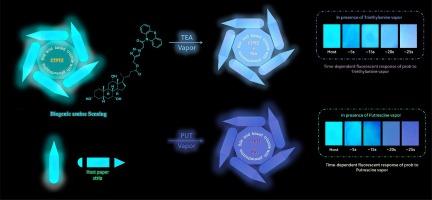Fluorescent-based bile acid triazole-phenothiazine derivatives: Multiphase detection of biogenic amines and application in spoiled foods
IF 4.9
2区 化学
Q1 CHEMISTRY, ANALYTICAL
引用次数: 0
Abstract
Amines are ubiquitous in biological world, yet are toxic and harmful in nature. To preserve the quality and safety of these packaged meals, it’s critical to identify biogenic amines that are emitted from spoiled meat, fish, or dairy products. To this endeavour, herein we report bile acid based triazole derivative with phenothiazine that are capable of sensing various amines by rapid change of fluorescence colour or intensity. The triazole derivatives exhibit a multiphase sensing platform by effectively sensing amine vapours or solutions in both solid and solution phases. Probes in the vapour state exhibit very quick interaction to primary amines (26 s for CTPTZ) and strong sensitivity to putrescine, which is a common example of biogenic amines (BAs). We have employed our unique sensing triazole derivative as a spoilage indication for meat. It detects biogenic amines from spoiled food and produces an optical response. Significant changes in both visual and luminescent were noted within 4–18 h of packaging at room temperature (∼25 °C). The rapid response that biogenic amines provide to these molecular sensors makes them highly promising for applications in the food packaging industry, medical diagnostics, and other sensory devices.

基于荧光的胆汁酸三唑-吩噻嗪衍生物:生物胺的多相检测及在变质食品中的应用
胺在生物界中无处不在,但却有毒有害。为了保证这些包装食品的质量和安全,识别变质肉类、鱼类或乳制品中释放的生物胺至关重要。为此,我们在此报告了基于胆汁酸的三唑衍生物与吩噻嗪,它们能够通过荧光颜色或强度的快速变化来感知各种胺。这种三唑衍生物是一种多相传感平台,能在固相和溶液相中有效地传感胺蒸气或溶液。气态探针与伯胺的相互作用非常迅速(CTPTZ 为 26 秒),对腐胺(生物胺 (BA) 的常见例子)的灵敏度也很高。我们采用了我们独特的三唑衍生物作为肉类变质的指示剂。它能检测变质食品中的生物胺,并产生光学反应。在室温(∼25 °C)下,包装后 4-18 小时内,视觉和发光都发生了显著变化。生物胺对这些分子传感器的快速反应使其在食品包装工业、医疗诊断和其他感官设备中的应用前景十分广阔。
本文章由计算机程序翻译,如有差异,请以英文原文为准。
求助全文
约1分钟内获得全文
求助全文
来源期刊

Microchemical Journal
化学-分析化学
CiteScore
8.70
自引率
8.30%
发文量
1131
审稿时长
1.9 months
期刊介绍:
The Microchemical Journal is a peer reviewed journal devoted to all aspects and phases of analytical chemistry and chemical analysis. The Microchemical Journal publishes articles which are at the forefront of modern analytical chemistry and cover innovations in the techniques to the finest possible limits. This includes fundamental aspects, instrumentation, new developments, innovative and novel methods and applications including environmental and clinical field.
Traditional classical analytical methods such as spectrophotometry and titrimetry as well as established instrumentation methods such as flame and graphite furnace atomic absorption spectrometry, gas chromatography, and modified glassy or carbon electrode electrochemical methods will be considered, provided they show significant improvements and novelty compared to the established methods.
 求助内容:
求助内容: 应助结果提醒方式:
应助结果提醒方式:


